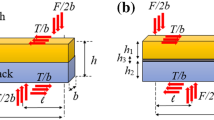Abstract
A systematic investigation and characterization of the interfacial fracture toughness of the bi-material copper leadframe/epoxy molding compound is presented. Experiments and finite element simulations were used to investigate delamination and interfacial fracture toughness of the bi-material. Two dimensional simulations using virtual crack closure technique, virtual crack extension and J-integral proved to be computationally cheap and accurate to investigate and characterize the interfacial fracture toughness of bi-material structures. The effects of temperature, moisture diffusion and mode-mixity on the interfacial fracture toughness of the bi-material were considered. Testing temperature and moisture exposure significantly reduce the interfacial fracture toughness, and should be avoided if possible.


















Similar content being viewed by others
References
Agrawal A, Karlsson AM (2006) Obtaining mode mixity for a bimaterial interface crack using the virtual crack closure technique. Int J Fract 141:75–98
Anderson TL (2005) Fracture mechanics-fundamentals and applications. CRC Press, Boca Raton, FL
Chan EKL, Yuen MMF (2009) Study of interfacial moisture diffusion at epoxy/Cu interface. J Adhesion Sci Technol 23:1253–1269
Charalambides PG, Lund J, Evans AG, McMeeking RM (1989) A test specimen for determining the fracture resistance of bimaterial interface. J Appl Mech 111:77–82
Fan HB, Chung PWK, Yuen MMF, Chan PCH (2005) An energy-based failure criterion for delamination initiation in electronic packaging. J Adhesion Sci Technol 19:1375–1386
Hutchinson JW, Suo Z (1992) Mixed mode cracking in layered materials. Adv Appl Mech 29:63–191
Irwin GR (1957) Analysis of stresses and strains near the end of a crack traversing a plate. J Appl Mech 24:361–364
Jensen HM, Thouless MD (1993) Effects of residual stresses in the blister test. Int J Solids Struct 30:779–795
Komori S, Sakamoto Y (2009) Development trend of epoxy molding compound for encapsulating semiconductor chips. In: Materials for advanced packaging. Springer, Newyork, pp 339–363
Krueger R (2002) The virtual crack closure technique: history, approach and applications. ICASE, Hampton, VA
Liechti KM, Chai YS (1991) Biaxial loading experiments for determining interfacial fracture toughness. Trans ASME 58:680–687
Liechti KM, Chai YS (1992) Asymmetric shielding in interfacial. Fracture under in-plane shear. J Appl Mech 59:295
Rice JR, Sih GC (1968) Plane problems of cracks in dissimilar media. J Appl Mech 32:418–423
Shirangi MH, Gollhardt A, Fischer A, Müller WH, Michel B (2008) Investigation of fracture toughness and displacement fields of copper/polymer interface using image correlation technique. In: Proceedings of the 41st international symposium on microelectronics (IMAPS2008), Providence, USA
Shirangi HM (2010) Simulation-based Investigation of interface delamination in plastic IC packages under temperature and moisture loading. PhD thesis, Fraunhofer Institute IZM, Berlin, Germany
Swallowe GM (1999) Mechanical properties and testing of polymers. Springer Science and Business Media Dordrecht
Volinsky AA, Tymiak NI, Kriese MD, Gerberich WW, Hutchinson JW (1999) Quantitative modeling and measurement of copper thin film adhesion. Mat Res Soc Symp Proc 539:277–290
Wong CKY, Gu H, Xu B, Yuen MMF (2006) A new approach in measuring Cu-EMC adhesion strength by AFM. IEEE Trans Compon Packag Technol 29(3):543–550
Xie W, Sitaraman SK (2003) Investigation of interfacial delamination of a copper-epoxy interface under monotonic and cyclic loading: experimental characterization. IEEE Trans Compon Packag Technol 26(4):447–452
Author information
Authors and Affiliations
Corresponding author
Rights and permissions
About this article
Cite this article
Tran, H.T., Shirangi, M.H., Pang, X. et al. Temperature, moisture and mode-mixity effects on copper leadframe/EMC interfacial fracture toughness. Int J Fract 185, 115–127 (2014). https://doi.org/10.1007/s10704-013-9907-3
Received:
Accepted:
Published:
Issue Date:
DOI: https://doi.org/10.1007/s10704-013-9907-3




